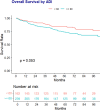Area deprivation index and breast cancer outcomes among patients in Western New York
- PMID: 40544410
- PMCID: PMC12259720
- DOI: 10.1007/s10549-025-07733-3
Area deprivation index and breast cancer outcomes among patients in Western New York
Abstract
Background: Several studies have shown that residing in regions with high area deprivation index (ADI) is associated with worse outcomes. We evaluated associations between ADI and breast cancer (BC) outcomes among patients in Western New York (WNY), a region that includes multiple underserved areas.
Methods: This retrospective, single-institution study analyzed data from 404 BC patients diagnosed between 2014 and 2018. Demographic and clinicopathological data were abstracted. Data were compared between high (≥ 60) and low (< 60) ADI groups, reflective of high and low levels of socioeconomic disadvantage, respectively. The primary objective was overall survival (OS) by ADI. Secondary objectives included assessment of recurrence free survival (RFS) or time to next treatment (TNT) by ADI and frequency of germline and somatic testing.
Results: Over half of the patients (59%) resided in ADI ≥ 60. 77% of patients had stage I-III BC and 23% had de novo metastatic BC. Patients in ADI ≥ 60 had a lower 5-year OS rate (73%) than those in ADI < 60 (84%) (95%CI: 67.5-79.7, P = 0.05). In multivariable analysis, similar trend was observed but was not statistically significant (HR 1.56, 95%CI: 0.98-2.46, P = 0.058). There were no differences in TNT or RFS by ADI. Germline testing was performed less frequently (33%) in ADI ≥ 60 than ADI < 60 group (45%) (P = 0.04) for patients with stage I-III BC, while no difference observed for stage IV patients. Finally, prevalence of somatic mutations in TP53, PIK3CA, and ESR1 were higher in ADI ≥ 60.
Conclusions: We observed a trend towards worse OS in areas with high ADI, though not statistically significant. The incidence of germline testing was lower in high ADI compared to low ADI regions.
Keywords: Area deprivation index; Breast cancer; Healthcare disparities.
© 2025. The Author(s).
Conflict of interest statement
Declarations. Conflict of interest: The authors have no conflicts of interest to declare.
Figures





Similar articles
-
Impact of residual disease as a prognostic factor for survival in women with advanced epithelial ovarian cancer after primary surgery.Cochrane Database Syst Rev. 2022 Sep 26;9(9):CD015048. doi: 10.1002/14651858.CD015048.pub2. Cochrane Database Syst Rev. 2022. PMID: 36161421 Free PMC article.
-
Risk-reducing bilateral salpingo-oophorectomy in women with BRCA1 or BRCA2 mutations.Cochrane Database Syst Rev. 2018 Aug 24;8(8):CD012464. doi: 10.1002/14651858.CD012464.pub2. Cochrane Database Syst Rev. 2018. PMID: 30141832 Free PMC article.
-
The effectiveness and cost-effectiveness of carmustine implants and temozolomide for the treatment of newly diagnosed high-grade glioma: a systematic review and economic evaluation.Health Technol Assess. 2007 Nov;11(45):iii-iv, ix-221. doi: 10.3310/hta11450. Health Technol Assess. 2007. PMID: 17999840
-
Do Patients of Different Levels of Affluence Receive Different Care for Pediatric Osteosarcomas? One Institution's Experience.Clin Orthop Relat Res. 2025 Apr 1;483(4):748-758. doi: 10.1097/CORR.0000000000003299. Epub 2024 Oct 30. Clin Orthop Relat Res. 2025. PMID: 39485923
-
Optimisation of chemotherapy and radiotherapy for untreated Hodgkin lymphoma patients with respect to second malignant neoplasms, overall and progression-free survival: individual participant data analysis.Cochrane Database Syst Rev. 2017 Sep 13;9(9):CD008814. doi: 10.1002/14651858.CD008814.pub2. Cochrane Database Syst Rev. 2017. PMID: 28901021 Free PMC article.
References
-
- The Breast Cancer Facts & Figures 2022-2024. https://www.cancer.org/research/cancer-facts-statistics/breast-cancer-fa....
-
- Siegel RL, Giaquinto AN, Jemal A (2024) Cancer statistics, 2024. CA Cancer J Clin 74(1):12–49 - PubMed
-
- Ward E, Jemal A, Cokkinides V et al (2004) Cancer disparities by race/ethnicity and socioeconomic status. CA Cancer J Clin 54(2):78–93 - PubMed
-
- Wiese D, Stroup AM, Crosbie A et al (2019) The impact of neighborhood economic and racial inequalities on the spatial variation of breast cancer survival in New Jersey. Cancer Epidemiol Biomark Prev 28(12):1958–1967 - PubMed
MeSH terms
Grants and funding
LinkOut - more resources
Full Text Sources
Medical
Research Materials
Miscellaneous

